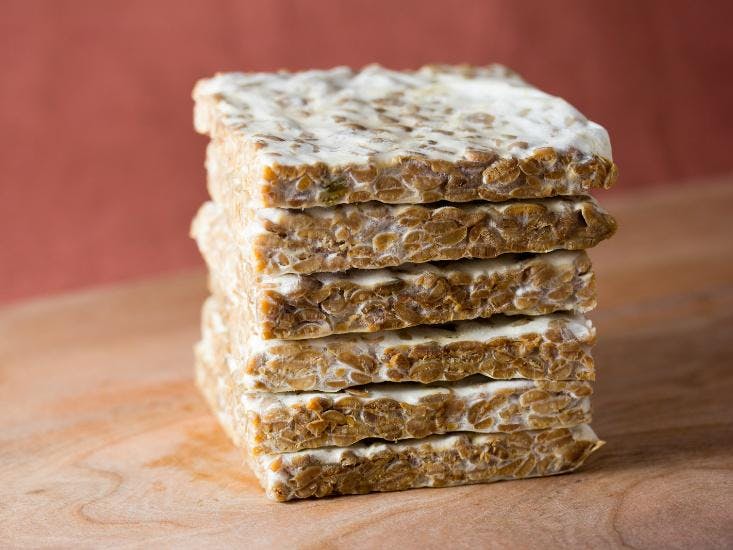Imagine a bowl of half-cooked beans coated in a layer of fibrous, white mold. Dotted across the surface of the mold are little black and blue spores. It smells faintly of ammonia.
Sound appetizing? It might seem too much like the remnants of last week’s edamame, but that moldy bean cake, or tempeh, is a vegan food du jour. Originally from Indonesia, tempeh is just one of a myriad of fashionable foods all produced through a process of controlled rotting, or fermentation.
Food ferments when microorganisms, either fungi or bacteria, metabolize its sugars and convert them to acid. These acids act as a natural preservative, keeping away competing microbes that can make us sick. So letting a food sit around and age can extend its life dramatically. This usefulness hasn’t gone unnoticed: In almost every world cuisine, fermented food can be found.
Many kinds of bread, the mainstay of our diets since time immemorial, are made using the yeast Saccharomyces cerevisiae, a fungus that converts carbohydrates into carbon dioxide (which forms the bubbles in bread) and alcohol (which evaporates during baking). Aside from bread, food modified by bacteria and fungi is everywhere, from the beer we drink, to the pickles we eat, to the miso soup we slurp. Practically every major culture has a different fermented food staple: in Korea it is fermented cabbage, or kimchi, while in India fermented rice and black chickpeas make up two breakfast staples, idli and dosa. Yogurt derives its characteristic tang from lactic acid produced by bacteria that ferment milk. Yeast is essential to producing wine (and all other alcoholic drinks), and different strains of the fungus native to various wine-making regions are prized for the different flavors they produce.
Fermentation has been so influential in human history that we can chart our civilizations’ development by it. The making of beer, first mentioned in the Sumerian epic Gilgamesh, written in about 3,000 BCE, may have been the genesis of cereal agriculture. Without the tempting taste of beer, we might not have settled down and become farmers, instead continuing our lives as nomadic hunter-gatherers. (A recent piece in Nautilus by Gloria Dawson lays out a fuller explanation for how beer may have domesticated humans.) Indeed, so crucial is fermentation to our development that it has become tied to ritual and identity. For Jewish people, a pickle can be traced to Middle Eastern origins, where pickling vegetables as a way of preserving them dates back about 5,000 years. For Christians, fermented foods are divine, embodying the blood (and, for some sects, the body) of Christ at communion. Pickling and preserving meat and vegetables was also instrumental in making long voyages, letting us sail across oceans, discover new lands, and settle colonies. Without its preserving qualities, European settlers may not have made it across the ocean to the Americas in the first place.
Of late, fermented foods have become a major health-food trend: In many fermented foods, there are armies of probiotic microbes that are presumed to enrich health in our intestines by improving the balance of microbial life there. In India, idli and dosa’s fermented rice and black chickpea fermented batter increases iron bioaccessibility by more than a hundred percent. In a country where iron deficiency is a widespread public health problem, it could be tradition and not medical advancement that provides the best medicine. The bacteria Lactobasillicus casei strain Shirota, found in fermented milk and in the supplement drink Yakult, has been shown to increase the activity of natural killer (NK) cells, which fight off viruses and kill cancer cells, if consumed every day. But while probiotics have been shown to have some measurable benefits in specific situations, finding out exactly which probiotic strains have what effects, in what doses, for which people, is complicated. Many of the questions are yet to be answered.
The ancient process of controlled rotting is also a current trend for foodies, as chefs experiment with the different flavors that fungus and bacteria can yield. Rated as the second-best restaurant in the world, Denmark’s NOMA feeds diners on milk curds and fermented fish eggs, or caviar. At New York’s Momofuku Ko, diners can expect pickled cabbage galore, black garlic yogurt, and pickled mustard seeds—innovations Chef David Chang has brought out from his Korean heritage and into the modern chef’s gourmet cuisine.
So while you chow down on your sauerkraut, spare a thought for your army of invisible dining companions—in the trillions per meal. They have helped us migrate across the planet, provided deeply meaningful rituals, and domesticate ourselves from hunter-gatherers to settlers. And most importantly, those moldy milk curds and fungus-filled grapes enhance one of the greatest joys in life: eating.
Claire Cameron is an intern with Nautilus.



